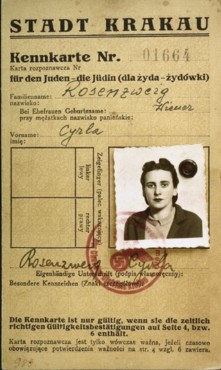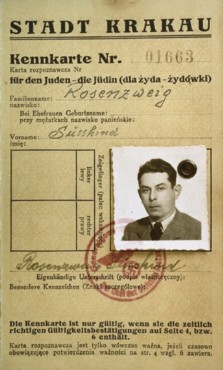Mike Rosenzweig, Ph. D.
Jewish-Polish Heritage
Poland revisited
 Two
competing Ariel Cafes in the Kazimierz district of Krakow offer live Jewish
music and delicious food. They provide a tantalizing glimpse of the vibrancy
of pre-war cafe culture. At that time Kazimierz was the center of Jewish
life in the city of Krakow. At one time there was only one Ariel Cafe run
by a young Polish couple. They had a falling out and decided to go separate
ways each desiring to lay claim to the name Ariel. They took the matter
before a magistrate who decided that it was a domestic dispute and refused
to render a verdict. He suggested that the couple resolve the matter themselves.
Since they were unable to do so we now have two Ariel Cafes.
Two
competing Ariel Cafes in the Kazimierz district of Krakow offer live Jewish
music and delicious food. They provide a tantalizing glimpse of the vibrancy
of pre-war cafe culture. At that time Kazimierz was the center of Jewish
life in the city of Krakow. At one time there was only one Ariel Cafe run
by a young Polish couple. They had a falling out and decided to go separate
ways each desiring to lay claim to the name Ariel. They took the matter
before a magistrate who decided that it was a domestic dispute and refused
to render a verdict. He suggested that the couple resolve the matter themselves.
Since they were unable to do so we now have two Ariel Cafes.

Remu Cemetery in Krakow, Poland
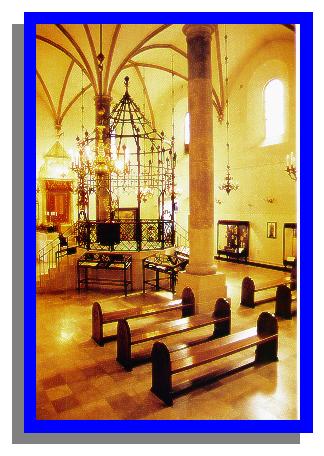
The Old Synagogue
It was probably built at the beginning of the
fifteenth century (1407). It was exclusively a men's synagogue rectangular,
with two naves and crossribbed vaulting supported on two columns,
walls supported by scarps and a gabled roof. The eastern wall adjoined
the city ramparts, which completely screened the synagogue. The twonave
interior alluded to the architecture of Gothic synagogues in Worms, Regensburg
and Prague. Onestory annexes were built next to it in the second half
of the sixteenth century a vestibule in the northwestern corner and
a prayer room for women at the western wall.
In 1570 the synagogue was rebuilt by the architect
Matteo Gucci of Florence. Its walls were made significantly higher and
crowned with an arcaded parapet, which has survived to this day in its
original form. The original crossribbed vaulting was restored in the
synagogue interior, supported on high Tuscan columns. The bimah in
the middle of the room, the Ark (Aronhakodesh) on the
eastern wall and the portal at the main entrance were new Renaissance details.
Later, more prayer rooms for women were added
the southern one at the end of the sixteenth century and the northern
one in the second quarter of the seventeenth century, together with a special
chamber for the Jewish community council, above the vestibule. Like the
vestibule, that room was connected with the council building, adjoining
the western annexes to the synagogue. The synagogue and the council building
formed the true religious and administrative center of Kazimierz's Jewish
community. This building complex survived until the 1880's, when the building
was pulled down.
The western facade, uncovered when the building
was demolished, was reconstructed by Jan SasZubrzych in 1891. Before
the First World War and afterwards, the synagogue underwent a long renovation,
after designs made by the wellknown Krakow architect Zygmunt Hendel
in 1904, 1913 and 1923. This work significantly improved the synagogue
physically and functionally and added NeoRenaissance detail to its
architecture, in harmony with its older historical structure.
The western annex was made straight to form
a right angle (its upper floor had been built in the nineteenth century
already), and a colonnade porch was added. The rooms above the vestibule
gained a new, broad staircase. The street level around the synagogue was
lowered down to its sixteenthcentury level, surrounded by a new decorative
fence.
During the Second World War, when the Germans
set up a ghetto in Podgorze and moved all the Jewish people who remained
in Krakow to the ghetto in March 1941, the synagogue was taken over by
the German Fiduciary Office and was used as an army warehouse. Its furnishings
were either destroyed or taken away. At the end of 1944 the vaulting collapsed,
perhaps purposely destroyed. After the war the synagogue remained abandoned
and ruined for several years. In the early 1950's some temporary protection
was ordered by the City Curator of Historic Monuments in Krakow.
In 195659, a complete renovation was done
by the Atelier for the Renovation of Historic Monuments in Krakow. The
vaulting in the main room, a new bimah, the Ark, the main portal
and the Baroque treasury box next to it were restored, and the uncovered
wall paintings underwent conservation. All the annexes to the main room
were substantially renovated. At the same time, the synagogue was adapted
to its new function as a Judaica museum. For this purpose, the former old
women's rooms, which at one time had separate entrances from the outside,
were connected by passageways to the men's synagogue, replacing the original
interior bays.
Upon completion of the work, the building owner,
that is the Jewish Religious Community in Krakow, transferred the Old Synagogue
building to the Historical Museum of the City of Krakow in perpetual usufruct.
A museum dedicated to the history and culture of Krakow's Jews was established
there.
Reminders of the Holocaust
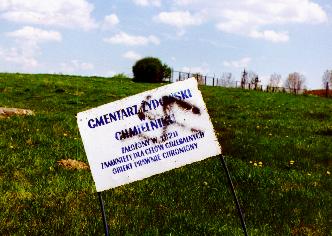
Chmielnik Cemetery was destroyed by German occupation forces in 1941.
Many of my ancestors were buried here. There are currently less than six
gravestones left. None remain standing. They lie on the ground and are
overgrown with weeds. The spray painted swastika is of recent vintage.
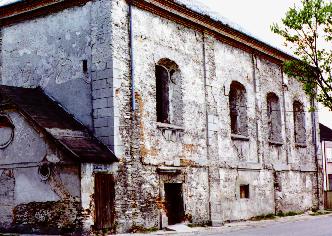
Chmielnik Synagogue blown up by retreating German Army in 1944. During
World War II it was used as a storehouse for German Army supplies. My grandparents
were married here in 1881. There has been some interest in restoration
by Americans with ancestors from this area.

Dzialoszyce Synagogue continues to lie in ruins. There are no local
funds available or interest in restoration. Most synagogues in Poland are
in this condition. The new restitution law returns jurisdiction to the
local Jewish Community, but since none exists the point is moot.
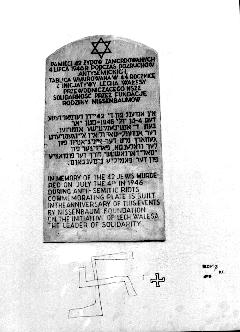
Memorial to the Kielce
Pogrom, July 4, 1946 in which 42 Jews were murdered. The pogrom was based
on a rumor that Polish children were being kept against their will in the
basement of a house at 7/9 Planty Street. The police patrols that were
sent to investigate immediately began telling people that Jews were kidnapping
children. The fact that the building had no basement did not deter them.
At 11:00 AM, police and soldiers entered the building, beat up the residents
and forced them into the yard where they were set upon by an angry mob.
Two soldiers broke into the room where Seweryn Kahane was trying to telephone
for help and shot him in the back of the head. In the early afternoon,
six hundred workers from a nearby factory joined the mob. Jews were clubbed
to death with fencing rails, iron bars and stones. On July ninth a trial
of the participants began. Nine rioters out of the several hundred participants
were convicted. On July fourteenth, after a refusal of presidential pardon,
they were executed by firing squad. As a result of this tragedy, more than
half of the 250,000 Jews living in Poland at the time immediately emigrated
to either Israel or the United States.
Work permits of Cyrla and Susskind Rosenzweig issued
during Nazi occupation of Krakow.
 Back
to Homepage
Back
to Homepage
 Two
competing Ariel Cafes in the Kazimierz district of Krakow offer live Jewish
music and delicious food. They provide a tantalizing glimpse of the vibrancy
of pre-war cafe culture. At that time Kazimierz was the center of Jewish
life in the city of Krakow. At one time there was only one Ariel Cafe run
by a young Polish couple. They had a falling out and decided to go separate
ways each desiring to lay claim to the name Ariel. They took the matter
before a magistrate who decided that it was a domestic dispute and refused
to render a verdict. He suggested that the couple resolve the matter themselves.
Since they were unable to do so we now have two Ariel Cafes.
Two
competing Ariel Cafes in the Kazimierz district of Krakow offer live Jewish
music and delicious food. They provide a tantalizing glimpse of the vibrancy
of pre-war cafe culture. At that time Kazimierz was the center of Jewish
life in the city of Krakow. At one time there was only one Ariel Cafe run
by a young Polish couple. They had a falling out and decided to go separate
ways each desiring to lay claim to the name Ariel. They took the matter
before a magistrate who decided that it was a domestic dispute and refused
to render a verdict. He suggested that the couple resolve the matter themselves.
Since they were unable to do so we now have two Ariel Cafes.






